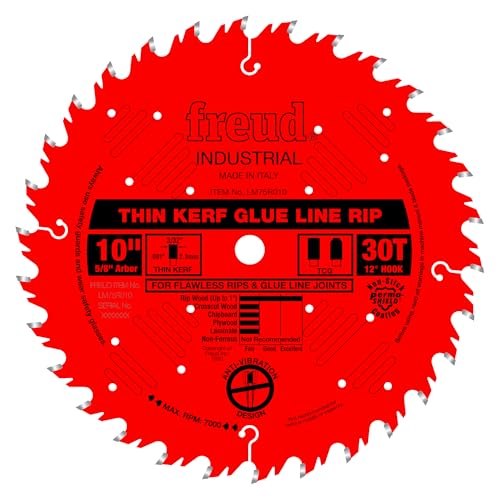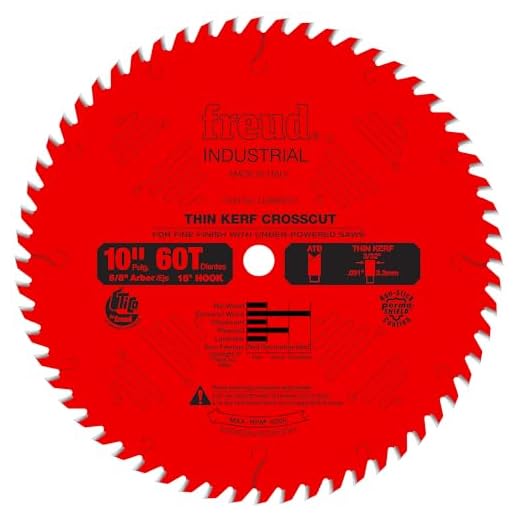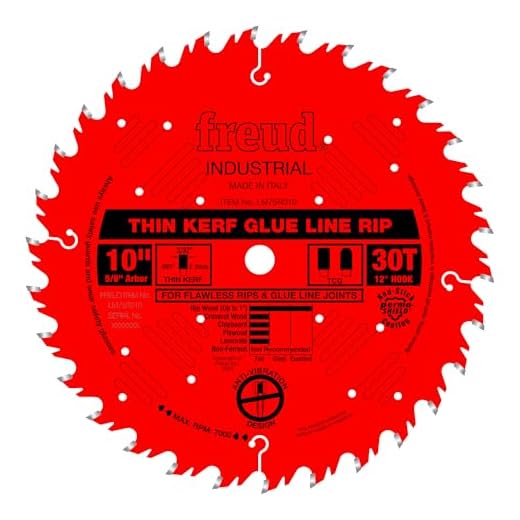




Choosing the right circular saw blade is crucial for the success of your woodworking projects. The blade you select will determine the quality of your cuts, the type of materials you can work with, and the overall efficiency of your work. With so many options available, it can be challenging to determine which blade is best for your specific needs.
One of the first factors to consider when choosing a circular saw blade is the material you will be cutting. Different materials require different types of blades. For example, if you will be cutting through wood, you will want a blade with larger, more spaced teeth. This will allow for efficient chip removal and prevent the blade from becoming bogged down. On the other hand, if you will be cutting through metal, you will need a blade with smaller, more closely spaced teeth to ensure clean, precise cuts.
Another important factor to consider is the size of the blade. Circular saw blades come in various sizes, ranging from 4 inches to 12 inches in diameter. The size of the blade you choose will depend on the type of project you will be working on and the depth of cut you require. Generally, larger blades are used for bigger, deeper cuts, while smaller blades are used for more intricate work.
Additionally, you should consider the tooth configuration of the blade. Blades with more teeth (such as 60 or 80 teeth) are ideal for fine woodworking, as they produce smooth, clean cuts. However, they may be slower at cutting through thicker materials. On the other hand, blades with fewer teeth (such as 24 or 30 teeth) are better suited for rough cutting or faster cutting through thicker materials.
In conclusion, choosing the right circular saw blade involves considering the material you will be cutting, the size of the blade, and the tooth configuration. By selecting the appropriate blade for your specific needs, you can ensure that your cuts are clean, accurate, and efficient.
Choosing the Right Circular Saw Blade
When it comes to using a circular saw, choosing the right saw blade is crucial for achieving clean and precise cuts. With the wide variety of blades available, it can be overwhelming to know which one to choose. Here are some factors to consider when selecting a circular saw blade:
Saw Blade Material
One of the first things to consider is the material of the saw blade itself. The most common materials used for circular saw blades are high-speed steel (HSS) and carbide-tipped. HSS blades are suitable for cutting wood and plastic, while carbide-tipped blades are more durable and can handle cutting through tougher materials like metal.
Number of Teeth
The number of teeth on the saw blade determines the cutting speed and the finish of the cut. Blades with more teeth provide a smoother cut but may cut slower, while blades with fewer teeth cut faster but may leave a rougher finish. Consider the type of material you are cutting and the desired result to determine the appropriate number of teeth.
Note: For general woodworking tasks, a blade with around 24-40 teeth is commonly used.
Blade Design
The design of the blade also plays a role in its performance. There are different tooth designs, including rip cut, cross cut, and combination blades. Rip cut blades have fewer teeth and are designed for cutting along the grain of the wood, while cross-cut blades have more teeth and are suitable for cutting across the grain. Combination blades are a versatile option that can handle both types of cuts.
Tip: If you frequently work on different types of projects, a combination blade is a good choice for its versatility.
By considering these factors and understanding the specific requirements for your project, you can choose the right circular saw blade to achieve optimal results. Remember to always prioritize safety when working with power tools and follow the manufacturer’s recommendations for blade usage.
Understanding Different Blade Types
When it comes to selecting a circular saw blade, it is important to understand the different types available and the specific tasks they are designed for. Choosing the right blade can make a significant difference in the quality and efficiency of your cuts. Here are some common blade types to consider:
- Rip Blades: These blades are designed for cutting wood along the grain, also known as ripping. They typically have fewer teeth with larger gullets to quickly remove material.
- Crosscut Blades: Crosscut blades are used for cutting wood across the grain. They have more teeth and smaller gullets to create clean and smooth cuts.
- Combination Blades: Combination blades are versatile options that can handle both ripping and crosscutting tasks. They have a mix of large and small teeth to provide efficient cutting for a variety of materials.
- Miter Blades: These blades are specifically designed for miter saws and are ideal for making precise angled cuts. They usually have a high tooth count to ensure clean and accurate cuts.
- Plywood Blades: If you work with plywood or other sheet materials, a plywood blade is essential. These blades have a high tooth count and ultra-sharp teeth to prevent splintering and produce smooth cuts.
- Metal Cutting Blades: For cutting through metal materials such as aluminum or steel, metal cutting blades are the best choice. They have fewer teeth and are made from special materials to handle the rigidity and hardness of metals.
It is important to select the right blade for the job to ensure optimal results and to prevent damage to the blade and your materials. Consider the type of material you will be cutting and the desired outcome before choosing a circular saw blade.
Consider the Material You’re Cutting
When choosing a circular saw blade, it is crucial to consider the material you’re cutting. Different materials require different types of blades to achieve the best results. The right blade will ensure clean and precise cuts, while the wrong blade can result in damage to the material or a poor quality cut.
Here are some common materials and the types of circular saw blades that work best for each:
- Wood: For cutting wood, a general-purpose ripping blade or a combination blade with a high tooth count is ideal. These blades have large, deep gullets to quickly remove material and teeth designed for clean cutting. If you need to make crosscuts or miter cuts in wood, a crosscutting blade with a lower tooth count and more beveled teeth is a better choice.
- Metal: When cutting metal, it is best to use a blade specifically designed for metal cutting. These blades have hardened steel teeth that are capable of cutting through metal without becoming damaged. They often have a special coating to reduce heat buildup and friction, ensuring a clean cut.
- Plastic: Cutting plastic requires a blade with a high tooth count and sharp, fine teeth. This type of blade creates smooth cuts with minimal chipping or melting. Saw blades with carbide or diamond-tipped teeth are best for cutting plastic.
- Masonry: For cutting masonry materials such as concrete, brick, or tile, a diamond-tipped circular saw blade is essential. These blades have synthetic diamond grit embedded in their teeth, which allows them to easily cut through tough materials. Make sure to choose a blade with a grit size appropriate for the material you’re cutting.
- Laminate: When cutting laminate materials, it’s crucial to use a blade with a high tooth count and special carbide tips. These blades are designed to reduce chipping and tearing of the laminate surface, ensuring a clean and smooth cut.
It is important to note that using the right blade also requires the proper speed and technique. Always consult the manufacturer’s recommendations and follow proper safety precautions when using a circular saw.
Choosing the Right Size and Tooth Count
When it comes to choosing a circular saw blade, one of the most important factors to consider is the size and tooth count of the blade. This will depend on the type of material you are cutting and the type of cut you are looking to achieve.
Blade size refers to the diameter of the circular saw blade. The most common blade sizes are 7 1/4 inches and 10 inches. The size of the blade will determine the maximum depth of cut the saw can make. For general cutting tasks, a 7 1/4-inch blade is usually sufficient. However, if you need to make deeper cuts, such as when working with thicker materials, a 10-inch blade may be more suitable.
The tooth count of the blade refers to the number of teeth on the blade. More teeth generally provide a smoother cut, while fewer teeth are better for faster, rougher cuts. Blade tooth counts typically range from 16 to 80 teeth. For general-purpose cutting, a blade with around 24 teeth is commonly used. If you need cleaner cuts, such as when working with finished materials, a blade with a higher tooth count, around 40 to 60 teeth, would be a better choice.
It is important to note that there is no one-size-fits-all solution when it comes to choosing the right size and tooth count for a circular saw blade. Factors such as the type of material, the thickness of the material, and the desired cut quality all need to be taken into consideration. It is always recommended to refer to the manufacturer’s guidelines and consult with professionals if you are unsure about the appropriate blade size and tooth count for your specific cutting needs.
Understanding Blade Coatings and Features
Choosing the right circular saw blade can greatly impact the quality of your cuts and the overall performance of your saw. One key aspect to consider is the coating and features of the blade. These coatings and features can enhance the blade’s durability, performance, and cutting capabilities. Here are some common blade coatings and features to understand:
- Carbide-tipped blades: These blades have carbide teeth that provide long-lasting cutting performance and can handle heavy-duty applications.
- Anti-friction coatings: These coatings reduce friction between the blade and the material being cut, allowing for smoother, faster cuts and reducing heat buildup.
- Anti-stick coatings: These coatings prevent the blade from gumming up with sawdust, resin, or other debris, resulting in cleaner cuts and a longer blade life.
- Expansion slots: These slots are designed to reduce heat buildup and prevent warping by allowing the blade to expand and contract during use.
- Noise reduction slots: Some blades feature noise reduction slots that help reduce the noise generated during cutting, making the sawing process more comfortable.
When choosing a circular saw blade, consider the materials you’ll be cutting and the level of performance you require. Different coatings and features can provide specific benefits for different applications. It’s also important to understand that blades may have a combination of these coatings and features, so be sure to read the product specifications to find the best blade for your needs.
Proper Maintenance and Safety Precautions
Using a circular saw blade requires proper maintenance and adherence to safety precautions to ensure safe and effective operation. Neglecting these precautions can result in accidents and injuries. Here are some important things to consider:
Maintenance
Regular maintenance of your circular saw blade is essential for optimal performance and longevity. Here are some maintenance tips:
- Keep the blade clean: After every use, remove any debris or buildup from the blade to prevent it from getting clogged or affecting its cutting ability.
- Sharpen the blade regularly: Dull blades can cause rough cuts and may lead to accidents. Use a file or a blade sharpener to keep the teeth sharp.
- Check for damage: Inspect the blade for any signs of wear, cracks, or missing teeth. Replace any damaged blades immediately.
Safety Precautions
To ensure your safety while using a circular saw blade, take the following precautions:
- Wear protective gear: Always wear safety goggles, ear protection, and gloves when operating the circular saw. Additionally, consider wearing a dust mask to protect yourself from dust and debris.
- Secure your workpiece: Make sure the material you’re cutting is properly fixed or clamped down to prevent it from moving or slipping during the cutting process.
- Follow the manufacturer’s instructions: Read and understand the user manual of your circular saw and follow the manufacturer’s instructions for safe operation.
- Position yourself correctly: Stand in a stable and balanced position while using the circular saw. Keep your body to the side of the blade, and never reach over the cutting line.
- Disconnect the power: Before performing any maintenance on the saw or changing the blade, make sure the power is disconnected.
By following these maintenance and safety precautions, you can ensure the proper functioning of your circular saw blade and minimize the risk of accidents and injuries.







